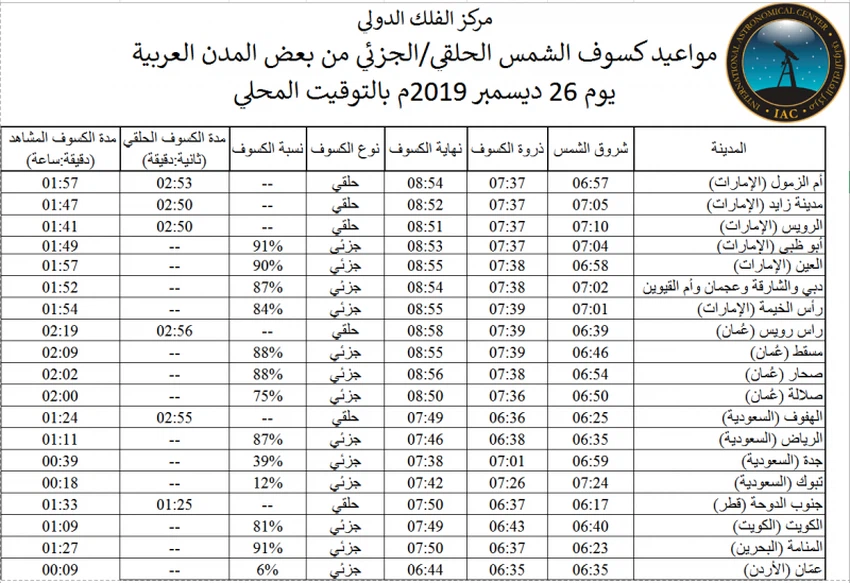Arab cities can see the eclipse of December 26, 2019
Weather of Arabia - Next Thursday, December 26, the world and the Arab region will witness an annular eclipse of the sun, a rare astronomical phenomenon.
When does an annular eclipse happen?
The annular eclipse occurs when the moon is located in front of the sun and its apparent diameter is slightly smaller than the apparent diameter of the sun, blocking the sun and leaving a piece surrounding the moon in the form of a luminous ring, and therefore called the annular eclipse, according to the statement of the International Astronomy Center.
As for the Gulf region, the areas that will witness the annular eclipse are located within a narrow strip with a diameter of about 155 km starting from the Sultanate of Oman passing through the Emirates and then Qatar and ending in eastern Saudi Arabia, while parts of these countries will see the event as an annular eclipse, but the rest of the Gulf regions will be able to see it Partial Eclipse.
Emirates
The narrow strip of the annular eclipse begins from the southeast of the country, centered around the Umm al-Zmul region and heading westward, crossing the Liwa region and Madinat Zayed, and then crossing the western coast of the state. Consequently, most of the south of the UAE will see the annular eclipse, while the other Emirates will witness the event as a partial eclipse only, and this includes Abu Dhabi, Al Ain and all other Emirates. On that day, the sun will shine with eclipse for all regions of the country, and then some regions will witness an annular eclipse. The duration of the annular eclipse at the center of the strip will be two minutes and 54 seconds. The eclipse will be 91% in Abu Dhabi, 90% in Al Ain, 87% in Dubai, and 84% in Ras Al Khaimah. The last annular eclipse witnessed by the state in 1847 AD, and the next will be in 2201 AD, God willing.
Sultanate of Oman
The narrow strip of the annular eclipse begins from the southeast of the Sultanate from the island of Masirah, and heads west across the southern half of Al Dakhiliya Governorate and then the southern half of Al Dhahirah Governorate. The eclipse will be 88% in Muscat and Sohar, and Salalah 75%. The last annular eclipse witnessed in the Sultanate in 1901 will be the next year in 2020, God willing.
Kingdom of Saudi Arabia
The narrow strip of the annular eclipse begins at the eastern coast, and ends quickly west of the city of Hofuf. The eclipse will be 87% in Riyadh and 39% in Jeddah. The last annular eclipse witnessed in the Kingdom in 1922 AD, and the next will be in 2049 AD, God willing.
Kuwait
Partial eclipses can be seen in all of its cities, and the more we head south, the greater the eclipse. In the capital, Kuwait, the eclipse percentage will be 80.96%, and its start according to local time at 6:40, and it will end at 7:48.
Diameter
The region from the middle of Doha to the south of Qatar will witness an eclipse as an annular eclipse, while the rest of the northern regions will see it as a partial eclipse.
Bahrain
Partial eclipses can be seen in all of its cities. In the capital, Manama, the proportion of the eclipse is 90.70%, and it starts at local time at 6:22, and it will end at 7:49.
Egypt
The end of the partial eclipse can be seen after sunrise on the eastern borders of the Red Sea coast at Ras Gharib for 3 minutes, in Hurghada for 7 minutes, and in Saint Catherine for 6 minutes.
The end of the partial eclipse can also be seen after sunrise in Sharm El Sheikh, Dahab, Taba, and Safaga for 9 minutes, in Quseir for 12 minutes, in Marsa Alam for 15 minutes, in Shalatin for 20 minutes, in Abu Ramad for 26 minutes, and in Halayeb 27 minutes .
Sudan
Seeing the end of the partial eclipse after sunrise on the eastern border, in Kassala the proportion of the eclipse will be 25.51%, and its start according to local time at 5:58, and will end at 6:31.
To whom
Partial eclipses can be seen in all cities, and the further east we go, the greater the eclipse. In the capital, Sanaa, the eclipse will be 54.55%, and it starts at local time at 6:26, and ends at 7:37.
Jordan
Partial eclipses can be seen in all cities, and the further east we go, the greater the eclipse. In the capital, Amman, the eclipse will be 4.45%, and it starts at local time at 6:34, and ends at 6:43.
Syria
Partial eclipses can be seen in all cities, and the further east we go, the higher the eclipse. In Deir Ezzor, the eclipse will be 17.49%, and it starts at local time at 6:26, and will end at 6:47.
Al-Ahsa .. The best cities in the world to see the annular eclipse on December 26
Iraq
Partial eclipses can be seen in all cities, and the more we turn to the southeast, the more the eclipse will be, for example in Basra. The eclipse will be 75.29%, and it starts at local time at 6:43, and it ends at 7:49.
The dates of the eclipse in some Arab cities are local time

Sources
International Astronomy Center
Moroccan Association for Science and Thought
Arabia Weather App
Download the app to receive weather notifications and more..



